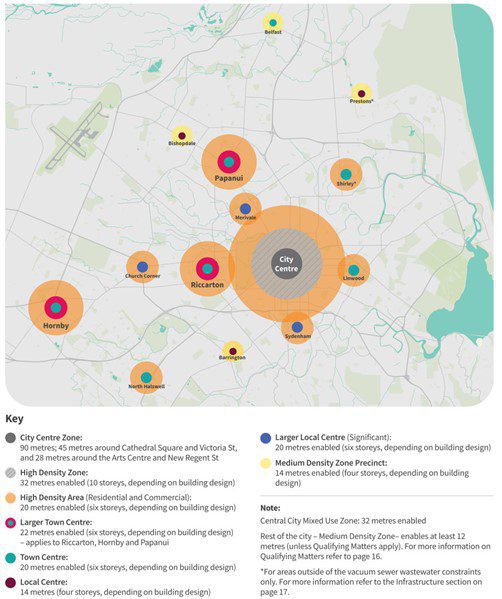The Christchurch City Council (CCC) has notified Plan Change 14 which will enable increased levels of development – in both density and height limits – across many residential and commercial zones.
These changes give effect to the Medium Density Residential Standards introduced by Government in legislation. This article provides a summary of the changes introduced by Plan Change 14, the process and potential for involvement, as well as key dates.
Who do these changes affect?
In short, everyone. The rules change the development that can occur without the need for resource consent, and therefore without the need for consultation.
For developers, or those looking to take advantage of the changes, the presence of qualifying matters will be critical to whether or not intensification can occur. For those opposing development in particular areas, arguments supporting additional qualifying matters may be required.
What are Medium Density Residential Standards?
Medium Density Residential Standards (MDRS) were introduced through the Resource Management (Enabling Housing Supply and Other Matters) Amendment Act. The MDRS impose a new permitted activity level of development in the regions identified as needing housing intensification – Auckland, Hamilton, Wellington, Tauranga and Christchurch.
The MDRS rules apply across all residential zones of the identified cities, unless qualifying matters are present which make intensification inappropriate. We explain the proposed qualifying matters further below.
When do they bite?
The Government intention was that the MDRS would apply from the date of notification. However, the CCC has proposed a city-wide qualifying matter (relating to sunlight and recession planes) that means the rules won’t kick in until a decision is made and the qualifying matters are confirmed. This is bad news for anyone with a development waiting in the wings, and follows on the back of the delays resulting from the CCC’s decision last year not to notify the plan change as legally required.
Where is intensification proposed?
All residential land is automatically zoned Medium Density Residential, apart from situations where a qualifying matter applies. This is the new ‘base line’ for zoning in the city, and allows for three dwellings up to three stories on every site.
We consider the primary issue for determination of how many houses can be erected will be the recession plane requirements and access to sunlight for each dwelling.
Around larger commercial centres and the central city, a High Density Residential Zone enables buildings up to six storeys (and higher in proximity to the central city).
Industrial land within close proximity of the central city (e.g. Sydenham, Addington and Phillipstown) will be rezoned to Mixed Use, allowing residential development alongside industrial or commercial uses.
Within the central city and commercial centres, the changes enable even greater development than the MDRS standards – although resource consent will likely still be required. Building Height Limits around these centres will be influenced by access to services, public transport, walking and cycling networks, and infrastructure available in these commercial centres.
The proposed intensification can be seen on the above map, which identifies the commercial centres around which the increased height limits apply.
What are the Christchurch qualifying matters?
In addition to the city-wide recession plane matter, the Council have proposed various other qualifying matters to limit where the MDRS standards apply. Details of these can be found online, but include:
- Public transport accessibility, to ensure areas not well serviced by public transport are not intensified to the same level;
- Natural hazards, mostly coastal inundation and erosion;
- Residential Heritage Areas and Character Areas (which sit alongside Plan Change 13 which deals with historic heritage);
- Land impacted by airport or port noise;
- Infrastructure constraints (sewer connections); and
- Areas required to maintain electricity and radio communications corridors.
The easiest way to understand the applicability of these is through the online maps where individual properties can be searched.
Financial contributions
Through the Housing Enabling Act, the Government has made changes to Financial Contributions which authorise the Council to require contributions for any development, even when a resource consent isn’t needed. These are different from Development Contributions which are charged through the resource consent process.
Financial Contributions are proposed to help mitigate some of the negative effects caused to the city’s tree canopy. To avoid paying for Financial Contributions, those developing land must either plant at least 20% tree-canopy cover on a site or retain existing trees. The Council has developed a calculator to assist with determining likely Financial Contributions.
What happens next?
Submissions on the proposal are open now until Wednesday 3 May. There is little point in opposing the MDRS rules – these are set in legislation. However, the application (or not) of qualifying matters are live issues.
A hearing will occur around October or November 2023, to be conducted by an Independent Hearings Panel. The Plan Change will be operative by April 2024.
Special thanks to Senior Associate Jamie Robinson for preparing this article. For site-specific advice and implications, please contact a member of our Resource Management team.
Disclaimer: The content of this article is general in nature and not intended as a substitute for specific professional advice on any matter and should not be relied upon for that purpose.




